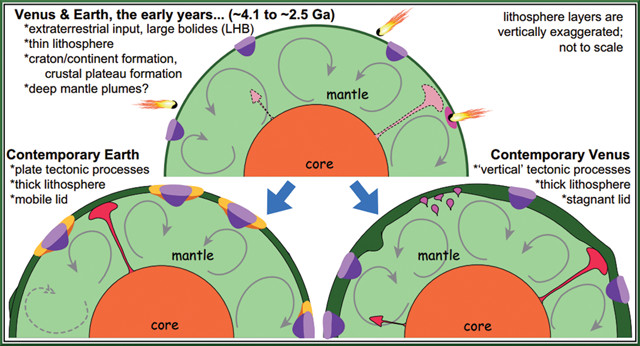
by Timothy Oleson Wednesday, December 23, 2015

Earth and Venus were probably far more tectonically similar billions of years ago, when massive impacting meteorites could have triggered the creation of early continental crust, according to a new study. Credit: V.L. Hansen, Lithosphere, 2015.
Massive meteorite impacts on Earth are destructive events, gouging enormous craters in the crust and raining debris over the planet’s surface. But such huge impacts may have also created some of its earliest continental kernels, called cratons, during Archean times.
Archean cratons, such as Western Australia’s Pilbara Craton and the Kaapval Craton of southern Africa, solidified more than 2.5 billion years ago and are composed of distinctive crustal rocks called granite-greenstone terranes underlain by deep, buoyant roots in the lithosphere. Many ideas for how these ancient provinces formed — often involving plate tectonic or mantle plume processes — have been suggested in the past, although the actual mechanism remains unclear.
Unlike existing notions, a newly hypothesized mechanism, described in a recent study in the journal Lithosphere by Vicki Hansen of the University of Minnesota at Duluth, invokes an extraterrestrial trigger. Hansen proposes that large meteorites hitting early Earth in the Archean could have penetrated through what was probably a thinner lithospheric skin at the time and into the mantle. The tremendous energy from the impacts would have melted the mantle locally, with the most buoyant portions of melt then flowing into the void left at the surface and forming new crust and lithosphere with different compositions from the surrounding rock.
The mechanism is essentially the same as one Hansen proposed previously to explain how features on Venus called crustal plateaus, possibly analogous to Earth’s Archean cratons, might have formed. Although the neighboring planets differ substantially now — Earth has active plate tectonics while Venus does not, for example — they were far more similar in their youth, Hansen noted in the study. For starters, each likely had a thin lithosphere compared to today and was bombarded by impactors — both necessary components in her model. The bolide-craton hypothesis, she wrote, offers a plausible alternative to other current hypotheses for Archean craton formation, though one that is “also not incompatible with the other mechanisms.”
© 2008-2021. All rights reserved. Any copying, redistribution or retransmission of any of the contents of this service without the expressed written permission of the American Geosciences Institute is expressly prohibited. Click here for all copyright requests.